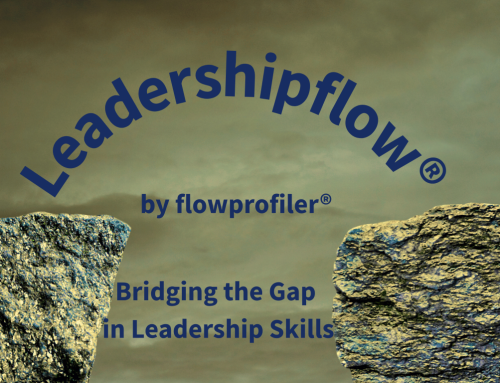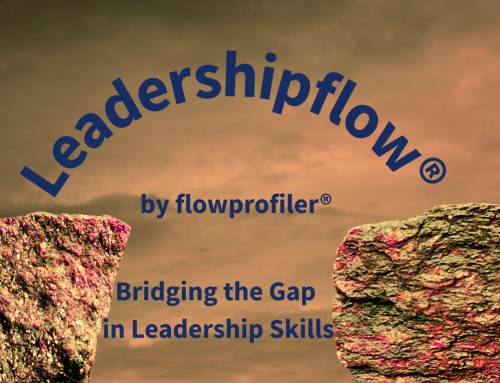
A question we get asked all the time!
At flowprofiler®, we know leadership is more than technical know-how. It’s about leaders showing up with the right attitude, aptitude, and approach, When leaders don’t follow through, it’s rarely about intent; it’s about capability gaps, misalignment, and missing support. Here are five reasons we see leaders stall, and how to close the gap.
1. Capability gaps across the Triple A Framework
The issue: Leaders may be skilled but lack resilience under pressure, or they may have the right mindset but struggle to apply behaviours consistently.
The evidence: Transfer of training depends on more than course content, it’s sustained by mindset, behavioural practice, and environment (Blume et al., 2010).
The solution: Assess across flowprofiler®’s Triple A Framework, Aptitude, Attitude, Approach, and build development pathways that integrate both behavioural and technical skills.
The Leadershipflow® Pathway does exactly this through diagnostic assessments, SkillSprints™, and structured reinforcement.
2. Misalignment with organisational messaging
The issue: Leaders may be busy but not always aligned to organisational goals, leaving teams confused.
The evidence: Research shows strategy often unravels not because it’s wrong, but because it’s poorly communicated or misaligned (HBR, 2015; MIT Sloan, 2018). McKinsey highlights that only 52% of employees believe their leaders effectively align strategy with execution.
The solution: Build clarity and consistency. Use visible, transparent goal frameworks. Leadershipflow® equips leaders to translate strategy into daily priorities that stick.
3. Poor organisational communication
The issue: Leaders assume communication has landed when in reality, messages are lost in translation. The result? Rework, wasted energy, and disengagement.
The evidence: PMI reports that ineffective communication is the primary contributor to project failure one-third of the time, and has a negative impact more than half the time (PMI, 2013; 2020).
The solution: Train leaders in clarity and brevity. Leadershipflow® integrates deliberate communication practice into every module, creating habits of precision and alignment.
4. Lack of confidence in addressing performance issues
The issue: Leaders hesitate to hold people accountable, avoiding difficult conversations. Performance slips, and high performers notice.
The evidence: HBR research shows many managers avoid giving both praise and constructive feedback (HBR, 2017). Academic evidence demonstrates that poorly delivered feedback can decrease performance (Kluger & DeNisi, 1996).
The solution: Build confidence through practice and psychological safety. Leadershipflow® supports leaders to rehearse feedback frameworks and embed accountability as a cultural norm.
5. No reinforcing mechanisms
The issue: After training, leaders return to “business as usual” without systems or incentives to sustain change.
The evidence: McKinsey’s Influence Model shows change sticks only when four levers are present: conviction, role modelling, skill building, and reinforcing mechanisms (McKinsey, 2015). Too often, the last lever is missing.
The solution: Install accountability loops. Leadershipflow® reinforces change with SkillSprints™, peer accountability, and visible progress tracking, ensuring leaders not only learn but follow through.
Why Leadershipflow® Pathways work
The Leadershipflow® Pathway is built on evidence and powered by flowprofiler® assessments. It aligns leaders to strategy, strengthens their behavioural and technical capability, and installs accountability into the culture. Leaders don’t just learn, they deliver.
👉Email us at hello@flowprofiler.com for more information

“Get of the fence and give it a go!”
– John Cummings, CEO, JC&S
“Leadershipflow® has made a huge
difference forus as a leadership team.I have seen a big shift in our leaders. It is really hitting home.“
– Chris Morrison, Operations Manager, Cupitt’s Estate
References
-
Blume, B. D., Ford, J. K., Baldwin, T. T., & Huang, J. L. (2010). Transfer of training: A meta-analytic review. Journal of Management, 36(4), 1065–1105.
-
Edmondson, A. (1999). Psychological safety and learning behavior in work teams. Administrative Science Quarterly, 44(2), 350–383.
-
Kluger, A. N., & DeNisi, A. (1996). The effects of feedback interventions on performance: A meta-analysis. Psychological Bulletin, 119(2), 254–284.
-
McKinsey & Company. (2015). The four building blocks of change. McKinsey Insights.
-
MIT Sloan Management Review. (2018). With Goals, FAST Beats SMART.
-
PMI – Project Management Institute. (2013, 2020). Pulse of the Profession®.
-
Harvard Business Review. (2015). Why Strategy Execution Unravels—and What to Do About It.
-
Harvard Business Review. (2017). Why Do So Many Managers Avoid Giving Praise?
-
Deloitte. (2023). Global Human Capital Trends.





